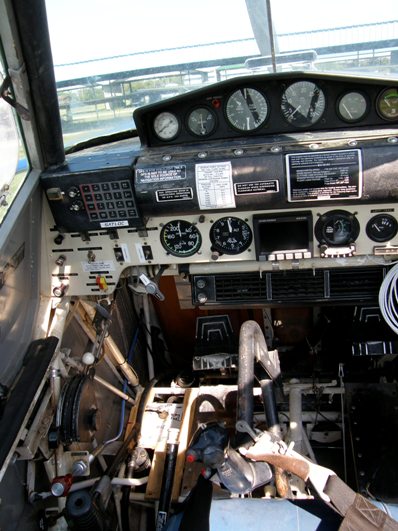Ever since I read the classic essay “Aviation or Flying? Take Your Pick” in Richard Bach’s book A Gift of Wings back in the 1980s, I’ve been thinking about the reasons why pilots fly, and how they go about it. In the last few decades, with the proliferation of GPS technology and glass cockpits, these topics have gotten particularly interesting.
Back when many of us learned to fly, we learned about pilotage, dead-reckoning, NDBs, and VORs because there was no choice. There was no simple way to fly Direct-to a point in space, and flight plans were something you worked out with pencil and paper before you even got into the airplane. The only things that glowed on our instrument panels were the frequencies in the radios.
The Cessna 152 I learned to fly in didn’t have an autopilot. When I eventually joined a club that owned a Cessna 172 , it had a simple single-axis Navomatic I was scared to use. (Mostly because the instructor who checked me out told me it never really worked properly and was usually more trouble than it was worth.) That was okay, because back then all the gadgets in the cockpit were merely tools that helped a pilot fly the airplane. These days, it’s as if everything has been turned on its head: the pilot manages the gadgets and the gadgets fly the airplane. If you don’t know how to use the gadgets, you’re not going anywhere. Or at least it seems that way.
For the past few months, Aidan (my Oddball Pilot co-founder) has been flying climbers and tourists onto Mt. Denali in Alaska. Meanwhile, I’ve been immersed in writing about glass cockpits for one client, and developing avionics courseware for another. Occasionally our worlds collide, and we find ourselves debating the merits of cockpit technology vs. good old fashioned stick and rudder flying.

A Cessna 188 AGtruck in El Salvador, just prior to a ferry leg to Ecuador. No automation here!
Last week, an interesting article on “automation addiction” made its way around the Internet, and provided some fodder for an interesting chat. Among other things, Aidan explained that this debate wasn’t really anything new.
“15 years ago I got checked out in the Cessna Caravan, and it was the first plane with an autopilot I’d flown,” he told me. “I loved that autopilot! Suddenly there was time to relax, do paperwork etc. After about a month in the plane I was talking to one of the old sage pilots up in Kotzebue. He was grouching about autopilots ruining all the new pilots and he sure hoped I wasn’t using it all the time. Embarrassed, I owned up to my new found love for ‘George.’ His response was remarkably practical: ‘if you’re going to use the damn thing, at least hand fly the climbs and descents. Then maybe you won’t forget how to fly!’ I’ve stuck pretty close to that rule and it seems to work well.”
Sounds like the big boys and the Feds are having similar conversations. While the article focuses on airline pilots and is written for the general public, it does bring up issues relevant to any pilot who uses cockpit technology and automation. For every old school pilot who struggles to learn how to use all the new gadgetry, there’s a young pilot who would be totally lost without it. That’s scary, even in a Cessna 172.
Oddball pilots have a unique challenge, because by definition they often find themselves straddling these two worlds, sometimes simultaneously. Moving from job to job (or juggling multiple jobs at once) means moving from airplane to airplane–some with glass cockpits and autopilots, some with little more than a stick and a rudder. Some oddball jobs are 100% VFR flying while others are always IFR. Many are an interesting and challenging mix.
While last week’s article is mainly about airline pilots who rarely need to rely on stick and rudder skills, it’s a thought-provoking read for anyone who flies or aspires to.
Update 10/02/11:
A reader just told us about an interesting article on this topic from Maclean’s magazine. The last three paragraphs are particularly interesting from an oddball pilot perspective. Especially this:
“That’s among the reasons that, five years ago, ICAO approved the creation of a ‘multi-crew pilot licence’ for commercial airlines. It allows would-be pilots to step into the co-pilot seat of a commercial airliner with as little as 240 hours of flying time, much of which can be done in a simulator. (In contrast, Strachan says most Air Canada pilots typically have nearly a decade of flying experience before they are hired.) The theory is that the job of a modern commercial airline pilot bears little resemblance to what it was 15 or 20 years ago, and that logging thousands of hours as a bush pilot or crop-duster is no longer as critical.”

I did my MCC about five years ago in a B737-200 FFS (All analogue which made for an easy transition from my Multi IR in PA34). The MCC course had the autopilot strictly off limits so it was all hand flown including SIDs, Climbs, Airways, Descents, Holds, STARS, ILS etc. The test profile (Dublin Ireland to Manchester England) included en route engine fire and shut down then asymmetric hold followed by vectors to the ILS, missed approach and finally circle to land. I didn’t go on to do a Type Rating in the 737 as I ran out of cash but if I had, I would be shocked if I didn’t get similar hands on training.